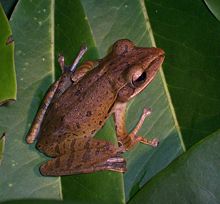| Polypedates | |
|---|---|

| |
| Polypedates leucomystax | |
| Scientific classification | |
| Domain: | Eukaryota |
| Kingdom: | Animalia |
| Phylum: | Chordata |
| Class: | Amphibia |
| Order: | Anura |
| Family: | Rhacophoridae |
| Subfamily: | Rhacophorinae |
| Genus: | Polypedates Tschudi, 1838 |
| Type species | |
| Hyla leucomystax Gravenhorst, 1829 | |
| Diversity | |
| 26 species (see text) | |
Polypedates is a genus of frogs in the family Rhacophoridae, the shrub frogs and Paleotropic tree frogs. They belong to subfamily Rhacophorinae. Members of this genus are collectively known as whipping frogs. They occur in eastern and southern Asia.
The delimitation of Polypedates versus the related Rhacophorus has been difficult. In former times, the present genus was often entirely included in Rhacophorus. However, molecular phylogenetic studies support the recognition of both genera. Polypedates + Taruga are considered to be the sister taxon of Feihyla + Rhacophorus.
Species
The following species are recognised in the genus Polypedates, with new species still being described on a regular basis:
- Polypedates assamensis Mathew & Sen, 2009
- Polypedates bengalensis Purkayastha et al., 2019
- Polypedates braueri (Vogt, 1911) – White-lipped treefrog or Java treefrog
- Polypedates colletti (Boulenger, 1890) – Collett's whipping frog, black-spotted tree frog, or Collett's tree frog
- Polypedates cruciger Blyth, 1852 – Sri Lanka whipping frog or common hour-glass tree-frog
- Polypedates discantus Rujirawan, Stuart, and Aowphol, 2013 – Malayan slender treefrog
- Polypedates hecticus Peters, 1863 – Samara flying frog
- Polypedates himalayensis (Annandale, 1912) – Himalayan tree frog
- Polypedates impresus Yang, 2008
- Polypedates insularis Das, 2005 – Nicobarese tree frog
- Polypedates iskandari Riyanto, Mumpuni & McGuire, 2011
- Polypedates leucomystax (Gravenhorst, 1829) – common tree frog, four-lined tree frog, striped tree frog, "white-lipped tree frog" (formerly often in P. maculatus)
- Polypedates macrotis (Boulenger, 1891) – Bongao tree frog
- Polypedates maculatus (Gray, 1830) – common Indian tree frog, Chunam tree frog
- Polypedates megacephalus Hallowell, 1861 – spot-legged tree frog, Hong Kong whipping frog, "brown tree frog"
- Polypedates mutus (Smith, 1940) – northern treefrog
- Polypedates occidentalis Das and Dutta, 2006 – western tree frog
- Polypedates otilophus (Boulenger, 1893) – file-eared tree frog, Borneo eared frog
- Polypedates pseudocruciger Das and Ravichandran, 1998 – false hour-glass tree frog or yellow tree frog
- Polypedates pseudotilophus Matsui, Hamidy, and Kuraishi, 2014
- Polypedates ranwellai Wickramasingha, Munindradasa, and Fernando, 2012 – Ranwella's spined tree frog
- Polypedates subansiriensis Mathew & Sen, 2009 – Subansiri's tree frog
- Polypedates taeniatus (Boulenger, 1906) – Bengal whipping Frog, Bengal whipping tree frog, or Terai tree frog
- Polypedates teraiensis (Dubois, 1987) – common tree frog, six-lined tree frog, Terai tree frog, or Perching frog
- Polypedates zed (Dubois, 1987) – Nepalese tree frog or Narayanghat whipping frog
The recently described Polypedates bijui has now been renamed as Beddomixalus bijui, the only species in its genus.
Phylogeny
The following phylogeny of Polypedates is from Pyron & Wiens (2011). 8 species are included. Polypedates is a sister group of Feihyla. Together, Polypedates and Feihyla form a sister group to Rhacophorus.
| Polypedates |
| ||||||||||||||||||||||||||||||||||||||||||
Kuraishi, et al. (2013) gives the following phylogeny of Polypedates. Polypedates and Rhacophorus are estimated to have split off from their most recent common ancestor 26.6 million years ago during the Oligocene. Furthermore, the genus Taruga has been separated as a separate genus endemic to Sri Lanka.
| Polypedates |
| |||||||||||||||||||||||||||||||||||||||||||||||||||||||||||||||||||||||||||
References
- ^ Frost, Darrel R. (2014). "Polypedates Tschudi, 1838". Amphibian Species of the World: an Online Reference. Version 6.0. American Museum of Natural History. Retrieved 9 December 2014.
- Li, Jiatang; Dingqi Rao; Robert W. Murphy; Yaping Zhang (2011). "The systematic status of rhacophorid frogs" (PDF). Asian Herpetological Research. 2: 1–11. doi:10.3724/SP.J.1245.2011.00001. Archived from the original (PDF) on 2013-12-03. Retrieved 2013-11-20.
- Purkayastha, Jayaditya; Das, Madhurima; Mondal, Kingshuk; Mitra, Shibajee; Chaudhuri, Anirban; Das, Indraneil (2019). "A new species of Polypedates Tschudi, 1838 (Amphibia: Anura: Rhacophoridae) from West Bengal State, Eastern India". Zootaxa. 4691 (5): 525–540. doi:10.11646/zootaxa.4691.5.6. PMID 31719380. S2CID 207936668.
- Zachariah, Dinesh, Kunhikrishnan, Das, Raju, Radhakrishnan, Palot & Kalesh, 2011
- ^ R. Alexander Pyron; John J. Wiens (2011). "A large-scale phylogeny of Amphibia including over 2800 species, and a revised classification of extant frogs, salamanders, and caecilians". Molecular Phylogenetics and Evolution. 61 (2): 543–583. doi:10.1016/j.ympev.2011.06.012. PMID 21723399.
- KURAISHI, N., MATSUI, M., HAMIDY, A., BELABUT, D. M., AHMAD, N., PANHA, S., SUDIN, A., YONG, H. S., JIANG, J.-P., OTA, H., THONG, H. T. and NISHIKAWA, K. (2013), Phylogenetic and taxonomic relationships of the Polypedates leucomystax complex (Amphibia). Zoologica Scripta, 42: 54–70. doi:10.1111/j.1463-6409.2012.00562.x
- Pan, S., N. Dang, J.S. Wang, Y. Zheng, D.Q. Rao, and J.T. Li. 2013. Molecular phylogeny supports the validity of Polypedates impresus Yang 2008. Asian Herpetological Research 4: 124–133.
- Identified by Pan, et al. (2013) as Polypedates impresus, but given in Kuraishi, et al. (2013) as Polypedates cf. mutus.
External links
 Media related to Polypedates at Wikimedia Commons
Media related to Polypedates at Wikimedia Commons
| Taxon identifiers | |
|---|---|
| Polypedates | |